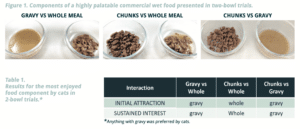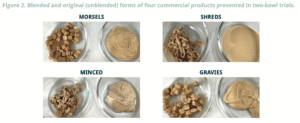More and more, pet parents want to know their dog is enjoying a meal in addition to simply eating it. If a meal is perceived as enjoyable, then there is a greater likelihood of a repurchase. We presented videos with different levels of dog feeding enjoyment (i.e., % Nose in...

Cats’ eating enjoyment informs preference for food components
Research at AFB International includes creative methods to measure palatability preference in cats and dogs for various food types, including those with multiple shapes and textures. Eating enjoyment is a dimension of palatability and can be interpreted by the pet’s interaction with the food, and/or by what pet parents perceive as they watch their pet eat.
In a recent study, we measured multiple responses during cats’ interactions with food and summarized them as Initial Attraction (First Approached, First Tasted, Duration of First Eating Bout) and Sustained Interest (Consumption, Uptake, Food Focus) to evaluate how individual food components of a chunks and gravy meal influence eating enjoyment. We found that cats indeed preferred gravy to other components of the meal, which supports many pet parent perceptions. Additionally, chunks were avoided in favor of anything with gravy, and when chunks alone were offered versus the whole chunks and gravy meal cats primarily licked the gravy from the chunks and gravy meal.
STUDY 1
Hypotheses: a) gravy alone would be preferred over chunks and gravy and over chunks alone, and b) chunks and gravy would be preferred over chunks alone. Supported.
*Anything with gravy was preferred by cats.
Based on the outcome of this study, we again measured cats’ interactions with foods (i.e., Initial Attraction and Sustained Interest) evaluating whether they prefer to lick rather than chew their meals. To do this we blended chunks and gravy meals in a food processor to achieve a homogenous, lick-able whole meal and offered it versus the original form of food. Specific responses within Sustained Interest indicated that the blended form of the meal was consumed more than the original form, likely because it was more efficient to consume. However, collectively, the additional measures suggested that cats enjoyed the original forms more than the blended forms.
Figure 1. Components of a highly palatable commercial wet food presented in two-bowl trials.

Based on the outcome of this study, we again measured cats’ interactions with foods (i.e., Initial Attraction and Sustained Interest) evaluating whether they prefer to lick rather than chew their meals. To do this we blended chunks and gravy meals in a food processor to achieve a homogenous, lick-able whole meal and offered it versus the original form of food. Specific responses within Sustained Interest indicated that the blended form of the meal was consumed more than the original form, likely because it was more efficient to consume. However, collectively, the additional measures suggested that cats enjoyed the original forms more than the blended forms.
Argentina | Australia | Brazil | China | Mexico | Netherlands | UnitedStates | afbinternational.com Argentina | Australia | Brazil | China | Mexico | Netherlands | UnitedStates
STUDY 2
Hypothesis: Cats prefer to lick rather than chew their chunks and gravy meals. Not supported.


Measures of eating enjoyment offer additional insight to the feeding experience of cats and dogs by describing how they are eating not just how much they eat. Here, Initial Attraction and Sustained Interest demonstrated that cats enjoy a specific component of a whole meal over other components. Unexpectedly these enjoyment measures also revealed more about cats’ eating experiences: licking, although efficient, is not the primary driver of enjoyment ofa wet meal.
AFB International continuously seeks to gain a better understanding of eating enjoyment as a dimension of palatability that helps to guide product improvements that ultimately provide a more satisfying eating experience for cats and their people. These methods can be applied to investigate palatability of many food matrices, such as heterogenous wet and dry foods, as well as their corresponding size, form, and texture.